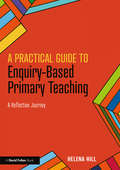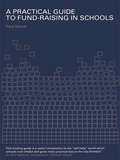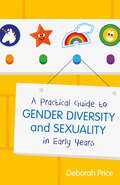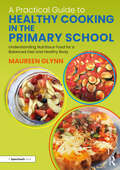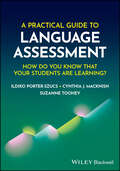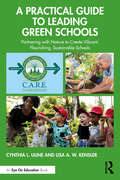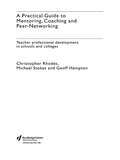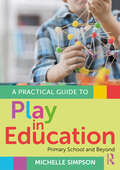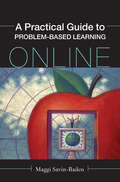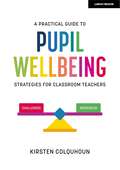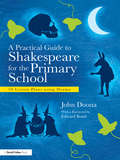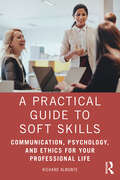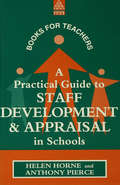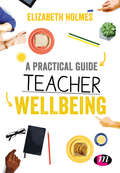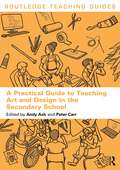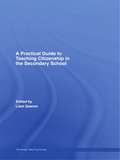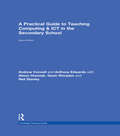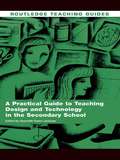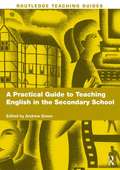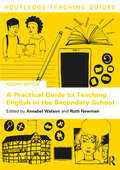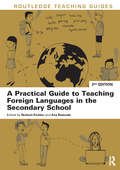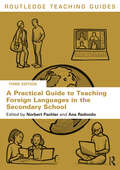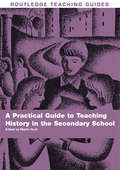- Table View
- List View
A Practical Guide to Enquiry-Based Primary Teaching: A Reflective Journey
by Helena HillThis book is a guide for developing an enquiry approach in primary schools and offers practical ideas on how to empower teachers to embrace spontaneity and flexibility in their daily practice. <P><P>Designed as a thinking diary, this book provides space for the practitioner to record highs and lows in the classroom and experiences in meetings and training, ensuring it serves as a personal record of what works well but also a pertinent reminder of what can improve and what can be learnt from mistakes. A Practical Guide to Enquiry-Based Primary Teaching comprehensively covers all the steps involved in adopting this approach, including: <li>why enquiry-based learning should be at the forefront of primary settings; <li>how to develop teachers in this approach and assessing the prior learning which needs to take place beforehand; <li>settling into your role as a facilitator and recognising the stregnths and weaknesses within your enquiry team; <li>discussing and planning enquiry sessions, including clarifying objectives; <li>how to let go of a more structured approach to learning and becoming familiar with the tools in your spontaneity arsenal; <li>evaluating enquiry sessions. <P><P>Supported by research, this book is a fresh, innovative approach to enquiry-based learning and teaching and will be a valuable daily aid for both newly qualified and experienced primary teachers.
A Practical Guide to Fund-Raising in Schools
by Paul MorrisA practical guide to fund-raising for schools. Funding for schools from the customary sources has become more difficult and schools are having to raise funds through schemes involving community and commercial support. This guide explains everything that schools need to know about funding, including;*researching funds available*commercial funding*government funding*European funding initiatives*business sponsorships*how to enter local partnerships*writing a bid*making and maintaining contacts*paperwork*legalities*staffing the funding team*target-setting and monitoring*the governing body's role.
A Practical Guide to Gender Diversity and Sexuality in Early Years
by Deborah PriceAiding discussion of gender diversity and sexuality with very young children, this practical guide helps practitioners explore these themes in early years settings. Promoting and extending current good practice, the book offers advice and activities that will support children in discovering their identity and also demonstrates how to work with parents. This guide presents a background to gender theory alongside examples and case studies, showing that activities and settings can work together for children to recognise their full potential in a supportive environment. This book addresses a wide variety of topics such as staff training and team management, how to support and promote men working in childcare, transgender issues and ways practice can be challenged, to give those working with young children a great foundation for teaching about diversity. Proposing aims that early years practitioners can work towards and providing practical ideas to take directly in to the workplace, this hands-on guide sets out to create and encourage outstanding practice for all professionals teaching young children.
A Practical Guide to Healthy Cooking in the Primary School: Understanding Nutritious Food for a Balanced Diet and Healthy Body
by Maureen GlynnAs part of the national curriculum, cooking provides children with a variety of skills, from learning the science behind where food comes from to what good health is and understanding how ingredients can be turned into something tasty to eat. Packed full of practical advice, colourful recipes, and nutritional guidance, this book will provide: Guidance to teach children a range of cooking skills, using a variety of ingredients from varying sources. An understanding as to where our food comes from; seasonal and all-year-round produce; how food is grown and transported to our shops and markets. The basic skills to make food safe, nutritious, and palatable to eat. Links to STEM, PSHE, and D&T primary school curriculum subjects. Ideal for group work for any primary classroom that has access to a school kitchen, either in mainstream primary or special school settings, this book offers teachers, parents, and other practitioners a useful, photocopiable resource for delivering practical and hands-on lessons with scientific grounding. With clear, easy to read, step-by-step, written, and illustrated recipes, this book provides all of the information needed to enable children, with supervision, to prepare and make tasty food, to share with family and friends, particularly on social and special occasions.
A Practical Guide to Language Assessment: How Do You Know That Your Students Are Learning?
by Ildiko Porter-Szucs Cynthia J. Macknish Suzanne TooheyAn essential resource on effective language assessment, invaluable for a new generation of teachers and education researchers A Practical Guide to Language Assessment helps educators at every level redefine their approach to language assessment. Grounded in extensive research and aligned with the latest advances in language education, this comprehensive guide introduces foundational concepts and explores key principles in test development and item writing. Authored by a team of experienced language teacher educators, this book addresses the potential impacts of poorly designed tools and prepares teachers to make informed, effective assessment decisions. Perfect for developing test blueprints and crafting effective assessment tools, including those for young learners, A Practical Guide to Language Assessment bridges the gap between theory and practice to provide the real-world training educators need to successfully navigate the complexities of modern language assessment. Clear and accessible chapters highlight the critical role of well-designed assessments, emphasize the importance of selecting appropriate tools to accurately measure student proficiency, and discuss recent innovations and emerging needs. With practical examples and a focus on current innovations, including ‘ungrading’ and the use of AI, A Practical Guide to Language Assessment: Explains the foundational concepts of language assessment with practical examples and clear explanations Bridges theoretical principles with practical applications, enabling educators to create effective test blueprints and assessment items and tasks Provides up-to-date coverage of timely topics such as the integration of AI in assessments and the ethical and legal considerations of language testing Features a wealth of in-depth examples of how theoretical concepts can be operationalized in practice A Practical Guide to Language Assessment is an essential read for students in language education, as well as teachers, assessment managers, professional development trainers, and policymakers in language program evaluation.
A Practical Guide to Leading Green Schools: Partnering with Nature to Create Vibrant, Flourishing, Sustainable Schools
by Lisa A. Kensler Cynthia L. UlineThis practical guide for educational leaders explores how you can transform your school or district into a vibrant center of learning and socio-ecological responsibility with only three manageable actions: taking students outside, bringing nature inside, and cultivating a mindset of awareness, responsibility, and empathy. This book is rich in practical, attainable approaches and stories of real actions taken by leaders, teachers, parents, and community partners to design, lead, and manage a vibrant, flourishing, sustainable learning community. Authors Uline and Kensler take you on an inspirational journey through nine key leadership strategies for you to begin or expand your work towards whole school sustainability.
A Practical Guide to Mentoring, Coaching and Peer-networking: Teacher Professional Development in Schools and Colleges
by Christopher Rhodes Geoff Hampton Michael StokesWritten for staff in schools and colleges, this book offers the challenge and support necessary to understand, analyze and adopt coaching, mentoring and peer-networking mechanisms as an essential part of the development of professional learning within an organisation. Drawing on the new national strategy for professional development, it emphasises the importance of learning with and from other colleagues, helping your organisation to become a professional learning community and supporting the drive to raise standards and attainment. Organised into nine distinct but interrelated chapters, this is an invaluable sourcebook of practical information for in-service training. It contains a range of stimulating activities which engage the reader and encourages reflection on: * the nature and importance of professional development in schools and colleges* the potential benefits and difficulties associated with coaching, mentoring and peer-networking* factors essential to the successful establishment and management of coaching and mentoring programmes* team leadership and leadership coaching* the role of the coach, mentor and networker with respect to the creation of professional learning communities.
A Practical Guide to Play in Education: Primary School and Beyond
by Michelle SimpsonThe benefits of play for children’s learning are well-documented and well-researched. The evidence for its positive impact on brain development, social interactions, emotional wellbeing, and motor skills is widespread. So, why should this practice stop after the early years?A Practical Guide to Play in Education encourages teachers to reflect on their practice and consider how a play-based approach may enhance their teaching. It provides realistic, accessible ideas and resources to incorporate into practice while giving evidence to back up this approach. Divided into three clear sections, readers are guided through: An introduction to play in education, including theory, benefits, and potential challenges. Putting it into practice, such as setting up the classroom, resources for play, and adopting a playful ethos in a realistic and accessible way. Lesson plans in a variety of subjects, spanning from numeracy, to literacy, to health and wellbeing. This unique and practical book highlights the importance of play in helping children develop skills to support their future and demonstrates how this approach can be seamlessly integrated into teaching styles across primary and early secondary.
A Practical Guide to Problem-Based Learning Online
by Maggi Savin-BadenProblem-based learning online is a burgeoning area, crying out for support in all the disciplines, but particularly health, medicine, education and social care that are already advanced users of problem-based learning in higher education. This book provides highly grounded research based ways for those wanting to change problem-based learning modules and programs from face to face to online approaches, as well as those who have developed e-learning components but who want to adopt problem-based methods. Providing an overview of the current state of problem based learning online, it examines why we're moving from fact to face to online provision, considers existing forms of provision, outlines common mistakes and strategies to avoid future problems, and shows how to effectively facilitate learning. Illustrated by mini case studies and examples of international projects, it provides guidance on effective design, online collaboration and group dynamics, and explores the common, and complex, decisions faced when choosing which form of problem-based learning to adopt. Including practical information and resources for games and activities, scenarios of problem-based learning in the different disciplines, advice for supporting staff and students, and effectively evaluating the tools, skills and pedagogy needed for learning, this book is an essential guide for all practitioners involved in the design and delivery of problem based learning online.
A Practical Guide to Pupil Wellbeing: Strategies for classroom teachers
by Kirsten ColquhounEvery year thousands of research papers, guidance documents and educational aims are published on pupil mental health and wellbeing. Many of them offer insightful ideas and theories, but what is often lacking is a clear route for busy classroom teachers to apply these findings. A focus on wellbeing is here to stay, but what does it mean? How does it apply to the curriculum? And what is a teacher's role? This book critically explores the importance of being a research-informed teacher, assesses some of the key health and wellbeing areas that class teachers can directly affect, and offers practical advice on how to do this. Designed in part to create a clearer pathway for classroom teachers to ensure that, while already spinning their many existing plates, the health and wellbeing needs of their pupils can be met effectively.Teaching, like healthcare, has infinite capabilities to contribute to social improvement both for the individual and wider society. Teachers go above and beyond their job description every single day and face a myriad of challenges in doing so. This book will help to arm class teachers with a toolkit of information to help them succeed as teachers of health and wellbeing.
A Practical Guide to Pupil Wellbeing: Strategies for classroom teachers
by Kirsten ColquhounEvery year thousands of research papers, guidance documents and educational aims are published on pupil mental health and wellbeing. Many of them offer insightful ideas and theories, but what is often lacking is a clear route for busy classroom teachers to apply these findings. A focus on wellbeing is here to stay, but what does it mean? How does it apply to the curriculum? And what is a teacher's role? This book critically explores the importance of being a research-informed teacher, assesses some of the key health and wellbeing areas that class teachers can directly affect, and offers practical advice on how to do this. Designed in part to create a clearer pathway for classroom teachers to ensure that, while already spinning their many existing plates, the health and wellbeing needs of their pupils can be met effectively.Teaching, like healthcare, has infinite capabilities to contribute to social improvement both for the individual and wider society. Teachers go above and beyond their job description every single day and face a myriad of challenges in doing so. This book will help to arm class teachers with a toolkit of information to help them succeed as teachers of health and wellbeing.
A Practical Guide to Shakespeare for the Primary School: 50 Lesson Plans using Drama
by John DoonaShakespeare is one of our key historical figures but so often he remains locked behind glass and hard to reach. The purpose of this book is to unlock Shakespeare, to remove the tag of ‘high art’ that has surrounded his work and return him to the heart of popular culture where his plays began in the first place. In his foreword, playwright Edward Bond says of A Practical Guide to Shakespeare for the Primary School, ‘It is written with knowledge and experience of its subject – but also with the knowledge of the young people with whom that experience was shared‘. John Doona will inspire and motivate pupils and teachers alike to engage with Shakespeare in a fresh and accessible manner and provide clear, tried and tested schemes of work which demonstrate how engagement with the plays and their language can have a dramatic impact on children’s literacy and writing. As well as providing practical guidance to classroom delivery and performance, techniques, approaches and attitudes, this handbook also promotes learning outcomes linked to literacy targets and cross-curricular units of learning. The central chapters of the book form a comprehensive cross-curricular unit of work on four specific plays – The Tempest, Macbeth, A Midsummer Night’s Dream and Romeo and Juliet – providing background notes and historical facts linked to the plays, along with comprehensive schemes of work for immediate implementation and ideas for generating performance. Features unique to this resource include:- Free electronic ‘info-blasts’ to all book buyers containing electronic versions of key elements of the book as well as additional resources and lesson plans Drama for the Petrified - A crash course for teachers in the techniques, approaches and attitudes required to bring Shakespeare to life A chapter on Shakespeare and his life, including ‘Five minute Will’ a short comic scripted account of his life Comprehensive schemes of work, each including a Teachers’ Crib Sheet, Story Whoosh!, Story Jigsaw, Scheme Structure Map, edited scenes and additional classroom resources A Practical Guide to Shakespeare for the Primary School is an essential resource for all primary teachers, trainee teachers and drama practitioners, offering guidance, insight and compelling schemes of work for the study of Shakespeare through drama in the primary classroom.
A Practical Guide to Soft Skills: Communication, Psychology, and Ethics for Your Professional Life
by Richard AlmonteThis accessible text looks at the range of soft skills sought after by employers and provides a practical guide to developing and effectively demonstrating these skills. Soft skills -- including communication, customer service, teamwork, problem solving, and personal management -- represent a major component of any worker's professional identity. This book analyzes major soft skills, including both inward-facing soft skills (how workers manage themselves to effectively perform their work) and outward-facing skills (how workers effectively interact with others and in groups). It explores how these skills are rooted in fundamental areas of liberal arts including interpersonal communication, psychology, and ethics. It provides an active learning pedagogy, including creative exercises and case studies through which students can assess their understanding of underlying concepts and their application in real-world situations. The book can be used as a supplement for communication, business, and career-oriented courses, and it will be of interest to individual students and junior professionals as well as career counselors, postsecondary instructors across the curriculum, and professionals in human resources and learning and development.
A Practical Guide to Staff Development and Appraisal in Schools (Books For Teachers Ser.)
by Horne, Helen Pierce, AnthonyThis guide contains an overview of existing successful appraisal practices and practical suggestions for both those managing and undertaking appraisal. The book takes into account up-to-date policies and changes in appraisal.
A Practical Guide to Teacher Wellbeing: A practical guide
by Elizabeth HolmesTeacher wellbeing, or a lack of it, is a major concern for the teaching profession. Research shows that there is a recruitment and retention crisis with over a third of the school, FE and HE profession expecting to leave by 2020. This is a practical guide that will help trainee teachers prepare for what is, undoubtedly, a demanding job. It supports new teachers to be aware of themselves and to understand the schools and teaching sector so they better anticipate pressures and find their own way forward. With solutions and strategies that can be taken into practice, this guide will help new and early career teachers establish that all-important work/life balance and avoid burn out.
A Practical Guide to Teacher Wellbeing: A practical guide
by Elizabeth HolmesTeacher wellbeing, or a lack of it, is a major concern for the teaching profession. Research shows that there is a recruitment and retention crisis with over a third of the school, FE and HE profession expecting to leave by 2020. This is a practical guide that will help trainee teachers prepare for what is, undoubtedly, a demanding job. It supports new teachers to be aware of themselves and to understand the schools and teaching sector so they better anticipate pressures and find their own way forward. With solutions and strategies that can be taken into practice, this guide will help new and early career teachers establish that all-important work/life balance and avoid burn out.
A Practical Guide to Teaching Art and Design in the Secondary School (Routledge Teaching Guides)
by Peter Carr Andy AshA Practical Guide to Teaching Art and Design in the Secondary School bridges the gap between key themes in Art and Design education theory, professional practice and the classroom. This practical and accessible book introduces methods for the delivery of engaging Art and Design lessons that safely and meaningfully address the current key issues in the subject.Each chapter includes tasks to support trainee and early career teachers in implementing, reviewing and adapting their teaching. Chapters cover a range of core approaches to the curriculum such as powerful knowledge for the Art and Design teacher, the place of Art History in the curriculum and critical thinking in Art and Design learning. In addition, emerging cultural and political issues (such as decolonising the Art and Design curriculum, gender and sexuality, anti-ablism, sustainability and well-being) are explored in ways designed to guide teachers towards applying their own unique teaching style.Linking directly to the planning and delivery of the subject in Key Stages 3, 4 and 5, the book is divided into three sections: Imaginative Curiosity for the Art and Design Teacher Epistemological Curiosity for Teachers and Learners Critical Curiosity in the Art and Design Classroom Designed to be used independently or alongside the essential textbook Learning to Teach Art and Design in the Secondary School, this book is packed with practical strategies, teaching ideas and activities in every chapter. The book provides everything trainee and early career teachers need to reflect on and develop their teaching practice, helping them to plan lessons across the subject in a variety of teaching situations.
A Practical Guide to Teaching Citizenship in the Secondary School (Routledge Teaching Guides)
by Liam GearonIdeal for students and NQTs, this practical and accessible workbook is designed to develop basic teaching skills, and increase teachers’ knowledge and understanding of teaching citizenship. Filled with practical activities and materials to encourage users to analyze their own learning and performance and underpinned with research findings, this personal workbook can be written in directly to provide a useful record of progress. It also includes case studies, examples of current good practice and a range of tried-and-tested strategies for inspiration and guidance. Complementing Learning to Teach Citizenship in the Secondary School, this workbook can be used as part of an integrated course or independently as a standalone self-study book.
A Practical Guide to Teaching Computing and ICT in the Secondary School (Routledge Teaching Guides)
by Andrew Connell Neil Stanley Anthony Edwards Alison Hramiak Gavin RhoadesA Practical Guide to Teaching Computing and ICT in the Secondary School offers straightforward guidance and inspiration to support all trainee and newly qualified teachers, as well as their tutors and mentors. It will also be a source of support and ideas for qualified teachers who wish to develop their teaching of Computing as a subject, in light of recent changes to the National Curriculum. Grounded in the best research and practice available, it focuses on the key pedagogical issues which arise during teacher training and offers stimulating activities based on tried and tested strategies. Comprehensively updated and restructured to reflect recent changes in the curriculum, Initial Teacher Training Standards and classroom technologies, it covers key aspects of Computing and ICT teaching: Planning pupil learning and progression Managing the learning environment Using assessment to improve pupil learning and your own teaching Developing pupils’ understanding of key concepts and ideas in Computing, including Computational Thinking and Programming Pupils’ common misconceptions and how to avoid them Helping pupils appreciate good and bad effects of computing. A Practical Guide to Teaching Computing and ICT in the Secondary School, written by experts in the field, provides detailed examples of theory in practice, enabling you to analyse and reflect on your own teaching in order to ensure pupil learning is maximised.
A Practical Guide to Teaching Design and Technology in the Secondary School
by Gwyneth Owen-JacksonContaining a wealth of practical activities and materials that provide excellent opportunities to analyse learning and performance within Design and Technology, this book also includes case studies and examples of existing good practice and a range of tried-and-tested strategies. Specially designed to be written in directly it provides a useful record of progress and is accompanied by a Companion Website. Designed to be used by student teachers, NQTs and beginning teachers, this workbook covers each main specialist area of Design Technology: electronics and communications technology (ECT), food technology, materials technology and textiles technology. Topics covered include: design and technology in the school curriculum the importance of health and safety the use of ICT in the teaching of design and technology planning lessons managing the classroom assessment issues the integration of literacy, numeracy, citizenship and sustainability into design and technology your own professional development. This book complements the market-leading textbook Learning to Teach Design and Technology in the Secondary School (also published by Routledge), but can also be used equally successfully on its own.
A Practical Guide to Teaching English in the Secondary School
by Andrew GreenA Practical Guide to Teaching English in the Secondary School offers straightforward advice, inspiration and support for all training and newly qualified secondary English teachers. Based on the best research and practice available, it offers a wide range of tried and tested strategies and practical activities to ensure success in the secondary classroom. Illustrated throughout with examples of good practice and activities to promote careful thought, the Practical Guide covers key aspects of English teaching, including: Effective lesson planning and pupil progress Getting started with drama Teaching poetry successfully and enjoyably Media education and media studies - an introduction to the curriculum and designing schemes of work Teaching English Language Choosing and using fiction for all ages English Literature at A Level Opportunities for ICT in English Planning meaningful assessment. A Practical Guide to Teaching English in the Secondary School is an essential companion to the best selling Learning to Teach English in the Secondary School. Written by expert professionals, it provides detailed examples of theory in practice, enabling you to analyse and reflect on your own teaching in order to ensure pupil learning is maximised. Providing a combination of practical ideas, educational rationales and activities to stimulate personal thought and development, this book explores a wide range of issues pertinent to the teaching and learning of English in the 21st century.
A Practical Guide to Teaching English in the Secondary School (Routledge Teaching Guides)
by Annabel WatsonA Practical Guide to Teaching English in the Secondary School offers straightforward advice, inspiration and a wide range of tried and tested approaches to help you find success in the secondary English classroom. Covering all aspects of English teaching, it is designed for you to dip in and out of, and enable you to focus on specific areas of teaching, your programme or pupils’ learning. Fully updated to reflect what student and early career teachers see and experience when they enter the classroom, the second edition supports trainee and practicing teachers to teach in imaginative and creative ways to promote learning in English. Packed with ideas, resources, practical teaching activities and underpinned by the latest research into how children learn, the book examines the core areas of reading, writing and spoken English including: • Plays, poetry, non-fiction, myths and legends, drama and Shakespeare • Developing writing • Creative grammar • Talk and classroom dialogue • Media and digital writing • English across the curriculum • Well-being through writing • Literature and language post-16. Including tools to support critical reflection, A Practical Guide to Teaching English in the Secondary School is an essential companion for all training and newly qualified English teachers.
A Practical Guide to Teaching Foreign Languages in the Secondary School
by Norbert Pachler Ana RedondoHow can you effectively motivate young people to engage with foreign language learning? How can young people engage with new ideas and cultural experiences within and outside the classroom? The new edition of A Practical Guide to Teaching Foreign Languages in the Secondary School offers straightforward advice and inspiration for training teachers, NQTs and teachers in their early professional development. Written by a team of expert professionals, it offers a wide range of strategies for successful teaching in the languages classroom. Key topics covered include: Helping pupils develop better listening skills Effective speaking activities Choosing the best texts and technology for reading skills Teaching grammar Internet tools and services for teaching and learning Integrating formative assessment The intercultural dimension of language teaching Collaborating with primary schools and successful transition Teaching Arabic and Mandarin Working with TAs and FLAs Classroom research and reflective practice This fully revised and updated second edition includes new chapters on homework, motivation and less widely taught languages, while the core sections on reading and writing, planning, and culture and diversity have been significantly updated to reflect important changes in research, practice and policy. A Practical Guide to Teaching Foreign Languages in the Secondary School extends the popular Learning to Teach Foreign Languages in the Secondary School by providing detailed examples of theory in practice, based on the most up-to-date research and practice, as well as links to relevant sources supporting evidence-informed practice. ?It is an essential compendium of support and ideas for all those embarking upon their first steps in a successful career in teaching foreign languages.
A Practical Guide to Teaching Foreign Languages in the Secondary School (Routledge Teaching Guides)
by Norbert Pachler Ana RedondoHow can you effectively motivate young people to engage with foreign language learning? How can young people engage with new ideas and cultural experiences within and outside the classroom? The new and fully revised edition of A Practical Guide to Teaching Foreign Languages in the Secondary School offers straightforward advice and inspiration for training teachers, newly qualified teachers (NQTs) and teachers in their early professional development. Offering a wide range of strategies for successful teaching in the languages classroom, this third edition includes separate chapters on the core skills of reading, writing, speaking and listening and new chapters on pronunciation and the science of learning. The chapters provide detailed examples of theory in practice, based on the most up-to-date research and practice, as well as links to relevant sources supporting evidence-informed practice and cover: Strategies for planning engaging lessons Integrating formative and summative assessment Digital tools and services for teaching and learning Helping pupils develop better listening skills Effective speaking activities The role of scaffolds and models in developing writing skills Teaching grammar The intercultural dimension of language teaching The role of multilingualism in foreign language education Engaging with critical pedagogy A Practical Guide to Teaching Foreign Languages in the Secondary School is an essential compendium of support and ideas for all those embarking upon their first steps in a successful career in teaching foreign languages.
A Practical Guide to Teaching History in the Secondary School
by Martin HuntThis practical workbook contains all the advice, guidance and resources new and student history teachers need to reflect on and develop their teaching practice, helping them to plan lessons across the subject in a variety of teaching situations. Helpful features include: case studies examples of pupils’ work examples of existing good practice a range of tried-and-tested teaching strategies photocopiable resources and training materials activities in each chapter to help student history teachers analyze their learning and performance web links for further reading on evidence-based practice. Designed to be used independently or as an integrated extension of the popular textbook, Learning to Teach History in the Secondary School which provides detailed examples of theory in practice, this book is packed with examples of how to analyze practice to ensure maximized learning in the classroom.
